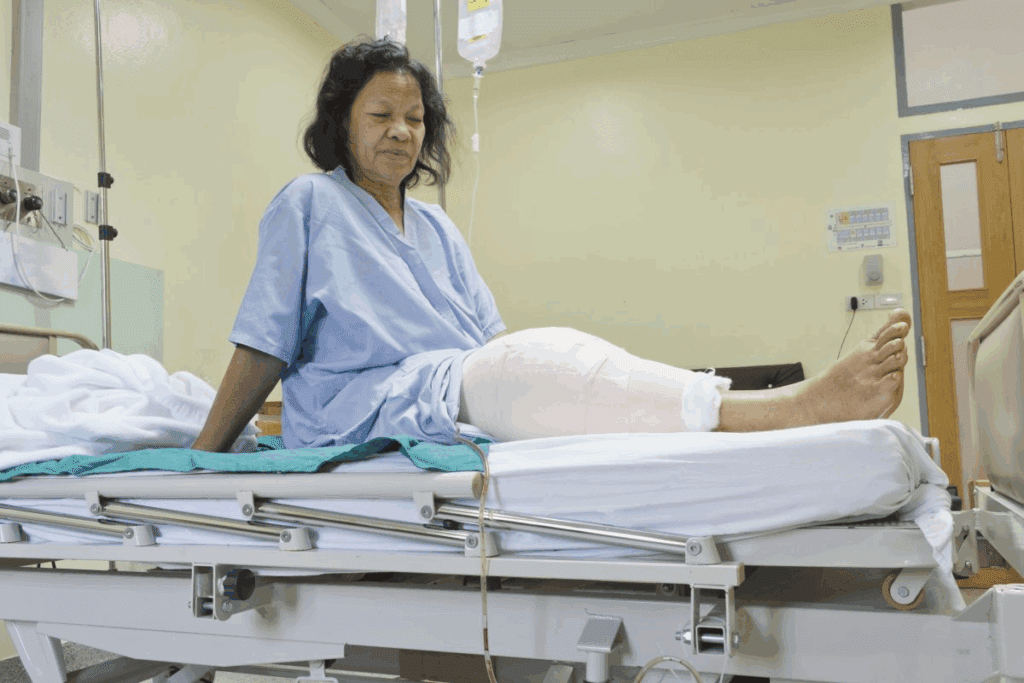
Chronic back pain can really hurt your body and mind. At Liv Hospital, we aim to give top-notch healthcare. We support patients from all over the world. Discover how long ablation surgery for back pain lasts and how the nerve burning procedure works.
Radiofrequency ablation (RFA) is a new way to fight chronic pain. A doctor uses a thin probe to send radiofrequency energy into the pain spot. This energy heats up and stops the pain nerves.
We know how much pain can affect you. Our team is here to help with the latest treatments like radiofrequency ablation. We’re all about giving you the best care.

Radiofrequency ablation (RFA) is a new way to treat chronic back pain. It helps those who haven’t found relief with other treatments. Let’s explore how this procedure works to ease back pain.
RFA uses heat from radiofrequency waves to stop pain signals. It targets nerves that send pain to the brain. This method is less invasive and can offer lasting pain relief.
RFA heats and destroys a small part of the nerve. This stops the nerve from sending pain signals. Studies show it can reduce pain for 6 months to 2 years, and sometimes longer.
Our team is here to help you every step of the way. Knowing how RFA works helps you choose the best treatment for you.

Radiofrequency ablation for back pain offers many benefits. It’s a minimally invasive alternative to traditional surgery. This makes it a good choice for those looking for relief without the risks of big surgeries.
RFA is known for being minimally invasive. It’s quick and doesn’t need general anesthesia or a hospital stay. This makes it a great option for those who want to avoid major surgery risks.
The recovery time for RFA is short. Patients might feel some discomfort right after, but it’s short-lived. This quick recovery is a big plus for those who need to get back to their daily life fast.
RFA has a good chance of giving long-term pain relief to those with chronic back pain. It works by blocking pain signals to the brain. This can greatly reduce pain and improve life quality for patients.
How long the pain relief lasts can vary. But many people see relief for six months to two years or more. This long relief helps patients do physical therapy and other rehab programs better.
RFA can lead to improved functionality and quality of life for patients. With less pain, people can do their daily activities, exercise, and live more actively.
Patients who get RFA often say they can do more without pain. This better functionality makes life better overall. It lets them do things they couldn’t do before because of pain.
To ease worries about the procedure, let’s explain how radiofrequency ablation works. We know getting a medical procedure can be scary. Knowing what to expect can make you feel more at ease.
Before starting radiofrequency ablation (RFA), patients get a full check-up. This includes looking at their medical history, doing a physical exam, and sometimes imaging tests. Our team checks if RFA is the right choice for the patient’s pain and health.
During prep, patients learn about any changes to their meds and what the procedure and recovery will be like. This helps lower risks and improve results.
The RFA procedure starts with a small needle or probe being placed in the skin. It’s guided to the pain source. Here’s what happens next:
We use top-notch technology and equipment for precise treatment. The system includes a generator, probe, and electrodes. The generator sends radiofrequency energy through the probe to the nerve.
X-ray or other imaging helps place the probe accurately. This makes the treatment more effective and safer. With the latest RFA tech, we aim for the best results for our patients.
Studies show about 75% of patients who had a successful RFA feel better with repeat treatments. This shows RFA can help manage pain long-term.
Knowing how long RFA lasts is key for planning your pain management. The time pain relief lasts after Radiofrequency Ablation (RFA) varies a lot. Some people feel better for months, while others may not feel relief for as long.
Studies show that RFA usually helps with pain for 6 months to 2 years. This time can change based on many things. These include your health, how bad your pain is, and the RFA method used.
“The nerves RFA kills will grow back,” says the reason behind RFA’s temporary fix. But, this doesn’t mean the treatment didn’t work. It just means you might need more treatments to keep the pain away.
Many things can change how long RFA’s pain relief lasts. These include:
Results from RFA can really vary. Some people might feel better for a long time, while others might need more treatments. Our team helps you understand these differences and creates a pain plan just for you.
By knowing what affects RFA’s lasting power, we can set better goals. This helps us work towards the best results for our patients.
Radiofrequency ablation is a great way to treat some types of chronic back pain. But, finding the right person for this treatment is key. We look at each patient closely to see if RFA is right for them.
RFA works well for pain in the lumbar facet joints, sacroiliac joint, and intervertebral discs. If other treatments haven’t helped, RFA might be a good choice for these conditions.
To find out if someone is a good fit for RFA, we do detailed tests. A big tool is the diagnostic pain receptor block injection. It helps find where the pain is coming from.
If the block injection really helps with pain, it shows RFA could work. We might also use MRI or CT scans to check the spine’s condition.
Even though RFA is helpful for many, there are times when it’s not right. These include:
We look at these things carefully to see if RFA is a good choice for a patient’s specific situation.
It’s key for patients to know what to expect after Radiofrequency Ablation. The recovery is usually easy, with most feeling little pain.
Right after the treatment, some might feel sore or uncomfortable where the treatment was done. These feelings are usually mild and go away in a few days.
Most can get back to their usual activities fast. But, it’s important to talk to your doctor before doing anything too strenuous. We help guide you through what to expect during recovery.
| Day | Expected Recovery Progress |
| 1-3 | Some soreness or discomfort, manageable with over-the-counter pain medication |
| 4-7 | Gradual improvement, resumption of light activities |
| 7+ | Return to normal activities, with continued improvement in pain relief |
Pain relief starts to show up a few weeks after the treatment. It might take some time to see the full effects of RFA. But, many people see a big improvement.
Knowing what to expect during and after the treatment helps patients prepare better. This leads to a better outcome.
Many studies show that Radiofrequency Ablation (RFA) works well for chronic back pain. Looking at RFA results helps us see its good and bad sides.
Clinical trials have looked into RFA’s success. They check if it helps with pain, improves function, and makes patients happy.
Success rates for RFA range from 45% to 75%. This means it can really help with pain. But, success can vary because of who gets treated, how it’s done, and aftercare.
Several things can affect how well RFA works. These include the medical condition, how well the pain source is found, and the patient’s health. Knowing these can help pick the right people for RFA.
| Predictor | Description | Impact on Success |
| Accurate Diagnosis | Correct identification of the pain source | High |
| Patient Selection | Choosing appropriate candidates based on medical history | High |
| Technical Proficiency | Skill level of the practitioner performing RFA | High |
About 75% of patients who get RFA once find relief again with more treatments. This shows RFA can be a good long-term choice for back pain.
By looking at studies and knowing what affects RFA success, we can tailor treatments. This way, we can help more people find relief.
RFA is known to manage back pain well, but it might need to be done again over time. The pain relief from RFA doesn’t last forever because the nerves grow back. It’s important for patients to know about getting RFA again for ongoing pain relief.
Research shows that getting RFA again can work just as well as the first time. About 75% of people find a lot of pain relief after getting it done again. This shows that RFA can be a good choice for managing pain over the long term.
How often you need to get RFA again can vary. It depends on how fast your nerves grow back and how bad your pain is. Usually, people need to get it done again every 6 to 12 months. Our team helps keep track of your progress to figure out when you might need it again.
Having a complete plan for managing pain is key to feeling better for a long time. This plan might include RFA, physical therapy, medicine, and changes in your lifestyle. We customize plans for each patient to make RFA work better and improve their life quality.
Here’s some data on how RFA can help in a long-term pain plan:
| Treatment Outcome | Initial RFA | First Repeat RFA | Second Repeat RFA |
| Significant Pain Relief | 60% | 75% | 70% |
| Moderate Pain Relief | 20% | 15% | 20% |
| Little or No Pain Relief | 20% | 10% | 10% |
By using RFA as part of a bigger pain management plan, people can keep feeling better from chronic back pain. Our team is dedicated to creating treatment plans that meet each patient’s specific needs and goals.
Our team uses a mix of treatments to get the best results. This way, we tackle back pain from different sides. It can lead to better and longer-lasting relief.
Using RFA with steroid injections can help with pain in the short term. Steroid injections reduce inflammation right away. RFA stops pain signals over time. “The combination of RFA and steroid injections can offer a synergistic effect, improving patient outcomes.”
Physical therapy is key in recovery and goes well with RFA. It makes moving easier and strengthens muscles. We create a special exercise plan for each patient to help manage pain.
Managing medications is also important in pain care. We check each patient’s meds to make sure they match their RFA treatment and health goals. This helps avoid side effects and boosts pain relief.
A leading pain management expert says,
“A multi-modal approach to pain management, including RFA, physical therapy, and medication management, offers the best chance for achieving significant and sustained pain relief.”
Radiofrequency ablation is a helpful treatment for chronic back pain. It’s a non-surgical, minimally invasive method. It can offer long-term pain relief and improve how well you can move and live your life.
While it’s mostly safe, there are rare risks like bleeding, infection, and nerve damage. Knowing the good and bad sides of RFA helps patients make smart choices. Our team is here to support and guide you every step of the way, aiming for the best results.
Looking at RFA’s role in pain management, it’s clear it’s a key part of a full treatment plan. By understanding its pros and cons, patients and doctors can work together to get the best results.
RFA is a procedure that uses heat to stop pain signals. It targets nerves that carry pain. This can give long-term relief from pain.
The time RFA lasts varies. It can be from months to over 2 years. Many factors, like health and treatment, affect how long it works.
RFA is less invasive than surgery. It can offer lasting pain relief and improve life quality. It can also be used with other treatments.
RFA uses advanced technology to target pain nerves. Our team will explain the process and what to expect during treatment.
Not everyone is right for RFA. We do tests to see if it’s good for you. It works best for certain types of chronic back pain.
Recovery from RFA is usually easy. You might feel sore or uncomfortable at first. These feelings usually go away in a few days. We’ll guide you through recovery.
Some people need RFA again to keep pain away. We’ll help you plan a treatment plan that includes RFA and other options.
Yes, RFA can work better with other treatments. We’ll create a plan that’s right for you, including RFA and other options.
Studies show RFA can help with chronic back pain. Success rates are between 45-75%. We’ll look at your results and adjust your treatment as needed.
Like any procedure, RFA has risks. We’ll talk about these with you and help you understand how to avoid them.
National Center for Biotechnology Information. (2025). How Long Does Radiofrequency Ablation Last for Back. Retrieved from https://pubmed.ncbi.nlm.nih.gov/31609391/
Subscribe to our e-newsletter to stay informed about the latest innovations in the world of health and exclusive offers!
WhatsApp us